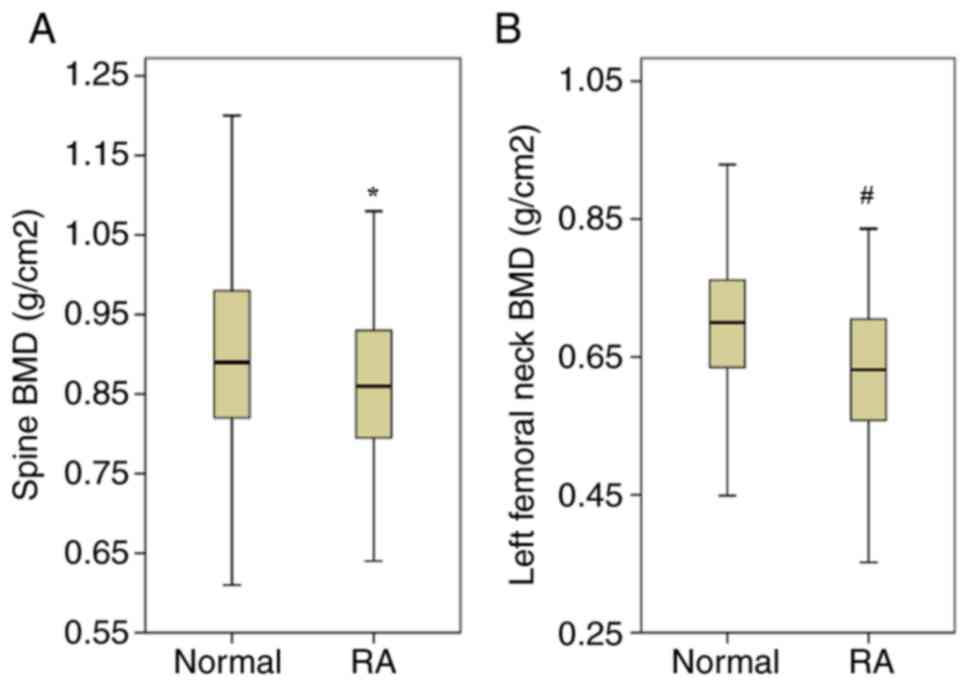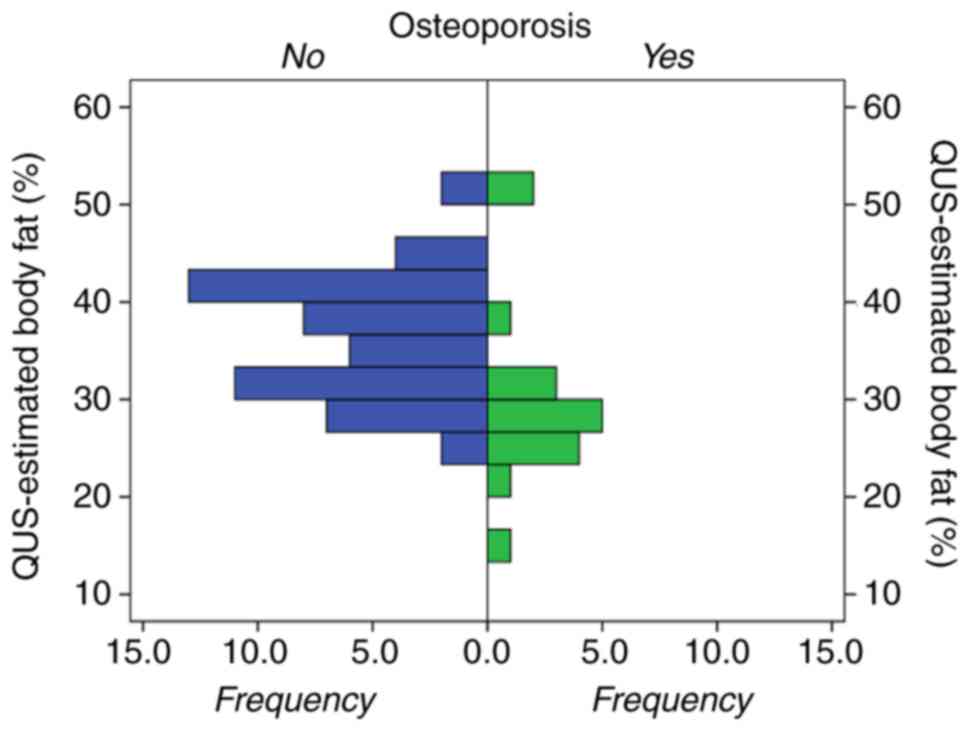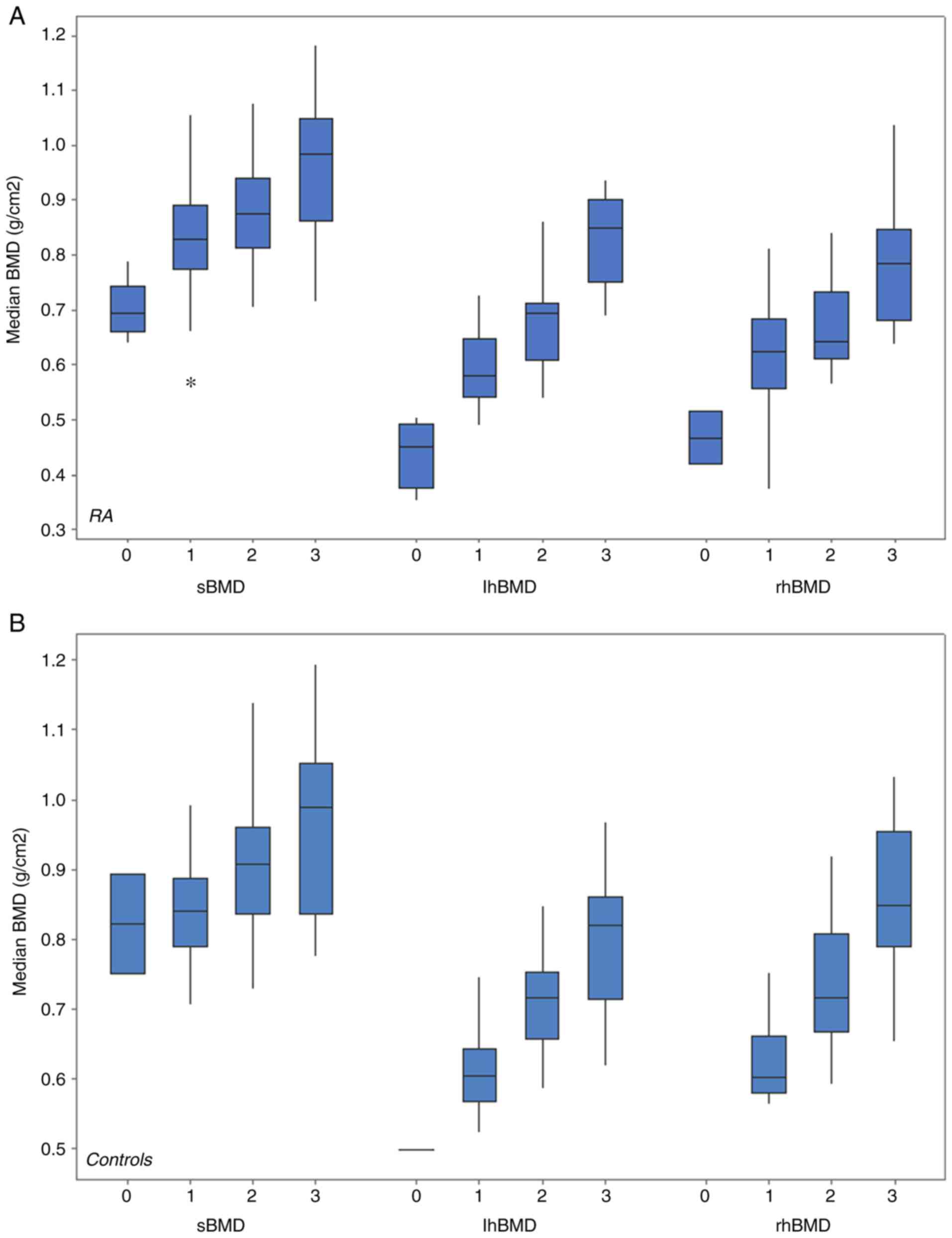|
1
|
Bliuc D, Alarkawi D, Nguyen TV, Eisman JA
and Center JR: Risk of subsequent fractures and mortality in
elderly women and men with fragility fractures with and without
osteoporotic bone density: The Dubbo Osteoporosis Epidemiology
Study. J Bone Miner Res. 30:637–646. 2015. View Article : Google Scholar : PubMed/NCBI
|
|
2
|
Diamantopoulos AP, Hoff M, Skoie IM,
Hochberg M and Haugeberg G: Short- and long-term mortality in males
and females with fragility hip fracture in Norway. A
population-based study. Clin Interv Aging. 8:817–823. 2013.
View Article : Google Scholar : PubMed/NCBI
|
|
3
|
Gutzwiller JP, Richterich JP, Stanga Z,
Nydegger UE, Risch L and Risch M: Osteoporosis, diabetes, and
hypertension are major risk factors for mortality in older adults:
An intermediate report on a prospective survey of 1467
community-dwelling elderly healthy pensioners in Switzerland. BMC
Geriatr. 18:1152018. View Article : Google Scholar : PubMed/NCBI
|
|
4
|
Fujiwara S, Zhao X, Teoh C, Jaffe DH and
Taguchi Y: Disease burden of fractures among patients with
osteoporosis in Japan: Health-related quality of life, work
productivity and activity impairment, healthcare resource
utilization, and economic costs. J Bone Miner Metab. 37:307–318.
2019. View Article : Google Scholar : PubMed/NCBI
|
|
5
|
Weycker D, Li X, Barron R, Bornheimer R
and Chandler D: Hospitalizations for osteoporosis-related
fractures: Economic costs and clinical outcomes. Bone Rep.
5:186–191. 2016. View Article : Google Scholar : PubMed/NCBI
|
|
6
|
Roux C: Osteoporosis in inflammatory joint
diseases. Osteoporos Int. 22:421–433. 2011. View Article : Google Scholar : PubMed/NCBI
|
|
7
|
Banas T, Hajdyla-Banas I, Pitynski K,
Nieweglowska D, Juszczyk G, Ludwin A, Knafel A and Ludwin I: Age at
natural menopause in women on long-term methotrexate therapy for
rheumatoid arthritis. Menopause. 23:1130–1138. 2016. View Article : Google Scholar : PubMed/NCBI
|
|
8
|
Chang K, Yang SM, Kim SH, Han KH, Park SJ
and Shin JI: Smoking and rheumatoid arthritis. Int J Mol Sci.
15:22279–22295. 2014. View Article : Google Scholar : PubMed/NCBI
|
|
9
|
Matcham F, Rayner L, Steer S and Hotopf M:
The prevalence of depression in rheumatoid arthritis: A systematic
review and meta-analysis. Rheumatology (Oxford). 52:2136–2148.
2013. View Article : Google Scholar : PubMed/NCBI
|
|
10
|
Matcham F, Rayner L, Steer S and Hotopf M:
The prevalence of depression in rheumatoid arthritis: A systematic
review and meta-analysis: Reply. Rheumatology (Oxford). 53:578–579.
2014. View Article : Google Scholar : PubMed/NCBI
|
|
11
|
Bombardier C, Barbieri M, Parthan A, Zack
DJ, Walker V, Macarios D and Smolen JS: The relationship between
joint damage and functional disability in rheumatoid arthritis: A
systematic review. Ann Rheum Dis. 71:836–844. 2012. View Article : Google Scholar : PubMed/NCBI
|
|
12
|
Legge A, Blanchard C and Hanly JG:
Physical activity and sedentary behavior in patients with systemic
lupus erythematosus and rheumatoid arthritis. Open Access
Rheumatol. 9:191–200. 2017. View Article : Google Scholar : PubMed/NCBI
|
|
13
|
Kan SL, Yuan ZF, Li Y, Ai J, Xu H, Sun JC
and Feng SQ: Alendronate prevents glucocorticoid-induced
osteoporosis in patients with rheumatic diseases: A meta-analysis.
Medicine (Baltimore). 95:e39902016. View Article : Google Scholar : PubMed/NCBI
|
|
14
|
DeVita MV and Stall SH: Dual-energy X-ray
absorptiometry: A review. J Ren Nutr. 9:178–181. 1999. View Article : Google Scholar : PubMed/NCBI
|
|
15
|
El Maghraoui A and Roux C: DXA scanning in
clinical practice. QJM. 101:605–617. 2008. View Article : Google Scholar : PubMed/NCBI
|
|
16
|
Tanner SB and Moore CF Jr: A review of the
use of dual-energy X-ray absorptiometry (DXA) in rheumatology. Open
Access Rheumatol. 4:99–107. 2012. View Article : Google Scholar : PubMed/NCBI
|
|
17
|
El Maghraoui A, Morjane F, Mounach A,
Ghazi M, Nouijai A, Achemlal L, Bezza A and Ghozlani I: Performance
of calcaneus quantitative ultrasound and dual-energy X-ray
absorptiometry in the discrimination of prevalent asymptomatic
osteoporotic fractures in postmenopausal women. Rheumatol Int.
29:551–556. 2009. View Article : Google Scholar : PubMed/NCBI
|
|
18
|
Iida T, Chikamura C, Aoi S, Ikeda H,
Matsuda Y, Oguri Y, Ono Y, Katada K and Ishizaki F: A study on the
validity of quantitative ultrasonic measurement used the bone
mineral density values on dual-energy X-ray absorptiometry in young
and in middle-aged or older women. Radiol Phys Technol. 3:113–119.
2010. View Article : Google Scholar : PubMed/NCBI
|
|
19
|
Pisani P, Renna MD, Conversano F, Casciaro
E, Muratore M, Quarta E, Paola MD and Casciaro S: Screening and
early diagnosis of osteoporosis through X-ray and ultrasound based
techniques. World J Radiol. 5:398–410. 2013. View Article : Google Scholar : PubMed/NCBI
|
|
20
|
Aventaggiato M, Conversano F, Pisani P,
Casciaro E, Franchini R, Lay-Ekuakille A, Muratore M and Casciaro
S: Validation of an automatic segmentation method to detect
vertebral interfaces in ultrasound images. IET Sci Measurement
Technol. 10:18–27. 2016. View Article : Google Scholar
|
|
21
|
Casciaro S, Peccarisi M, Pisani P,
Franchini R, Greco A, De Marco T, Grimaldi A, Quarta L, Quarta E,
Muratore M and Conversano F: An advanced quantitative echosound
methodology for femoral neck densitometry. Ultrasound Med Biol.
42:1337–1356. 2016. View Article : Google Scholar : PubMed/NCBI
|
|
22
|
Aletaha D, Neogi T, Silman AJ, Funovits J,
Felson DT, Bingham CO III, Birnbaum NS, Burmester GR, Bykerk VP,
Cohen MD, et al: 2010 rheumatoid arthritis classification criteria:
An American College of Rheumatology/European League Against
Rheumatism collaborative initiative. Arthritis Rheum. 62:2569–2581.
2010. View Article : Google Scholar : PubMed/NCBI
|
|
23
|
World Health Organization (WHO), .
Physical status: The use and interpretation of anthropometry.
Report of a WHO Expert Committee. World Health Organ Tech Rep Ser.
854:1–452. 1995.PubMed/NCBI
|
|
24
|
Casciaro S, Conversano F, Pisani P and
Muratore M: New perspectives in echographic diagnosis of
osteoporosis on hip and spine. Clin Cases Miner Bone Metab.
12:142–150. 2015.PubMed/NCBI
|
|
25
|
Conversano F, Franchini R, Greco A,
Soloperto G, Chiriacó F, Casciaro E, Aventaggiato M, Renna MD,
Pisani P, Di Paola M, et al: A novel ultrasound methodology for
estimating spine mineral density. Ultrasound Med Biol. 41:281–300.
2015. View Article : Google Scholar : PubMed/NCBI
|
|
26
|
Olszynski WP, Adachi JD, Hanley DA,
Davison KS and Brown JP: Comparison of speed of sound measures
assessed by multisite quantitative ultrasound to bone mineral
density measures assessed by Dual-energy X-Ray absorptiometry in a
large canadian cohort: The canadian multicentre osteoporosis study
(CaMos). J Clin Densitom. 19:234–241. 2016. View Article : Google Scholar : PubMed/NCBI
|
|
27
|
Kanis JA, McCloskey EV, Johansson H, Oden
A, Ström O and Borgström F: Development and use of FRAX in
osteoporosis. Osteoporos Int. 21 (Suppl 2):S407–S413. 2010.
View Article : Google Scholar : PubMed/NCBI
|
|
28
|
Glüer CC, Lu Y and Engelke K: Quality and
performance measures in bone densitometry. Part 2: Fracture risk.
Osteoporos Int. 17:1449–1458. 2006. View Article : Google Scholar : PubMed/NCBI
|
|
29
|
Hauser B, Riches PL, Wilson JF, Horne AE
and Ralston SH: Prevalence and clinical prediction of osteoporosis
in a contemporary cohort of patients with rheumatoid arthritis.
Rheumatology (Oxford). 53:1759–1766. 2014. View Article : Google Scholar : PubMed/NCBI
|
|
30
|
Lee JH, Sung YK, Choi CB, Cho SK, Bang SY,
Choe JY, Hong SJ, Jun JB, Kim TH, Lee J, et al: The frequency of
and risk factors for osteoporosis in Korean patients with
rheumatoid arthritis. BMC Musculoskelet Disord. 17:982016.
View Article : Google Scholar : PubMed/NCBI
|
|
31
|
Mobini M, Kashi Z and Ghobadifar A:
Prevalence and associated factors of osteoporosis in female
patients with rheumatoid arthritis. Caspian J Intern Med.
3:447–450. 2012.PubMed/NCBI
|
|
32
|
Hwang J, Lee EK, Ahn JK, Cha HS, Koh EM
and Lee J: Bone-density testing interval and transition to
osteoporosis in patients with rheumatoid arthritis. Osteoporos Int.
28:231–237. 2017. View Article : Google Scholar : PubMed/NCBI
|
|
33
|
Coulson KA, Reed G, Gilliam BE, Kremer JM
and Pepmueller PH: Factors influencing fracture risk, T score, and
management of osteoporosis in patients with rheumatoid arthritis in
the Consortium of Rheumatology Researchers of North America
(CORRONA) registry. J Clin Rheumatol. 15:155–160. 2009. View Article : Google Scholar : PubMed/NCBI
|
|
34
|
Zhou R, Lin X, Li DY, Wang XF, Greenbaum
J, Chen YC, Zeng CP, Lu JM, Ao ZX, Peng LP, et al: Identification
of novel genetic loci for osteoporosis and/or rheumatoid arthritis
using cFDR approach. PLoS One. 12:e01838422017. View Article : Google Scholar : PubMed/NCBI
|
|
35
|
Gong X, Xu SQ, Wu Y, Ma CC, Qi S, Liu W
and Xu JH: Elevated serum 14-3-3η protein may be helpful for
diagnosis of early rheumatoid arthritis associated with secondary
osteoporosis in Chinese population. Clin Rheumatol. 36:2581–2587.
2017. View Article : Google Scholar : PubMed/NCBI
|
|
36
|
Hussien YM, Shehata A, Karam RA, Alzahrani
SS, Magdy H and El-Shafey AM: Polymorphism in vitamin D receptor
and osteoprotegerin genes in Egyptian rheumatoid arthritis patients
with and without osteoporosis. Mol Biol Rep. 40:3675–3680. 2013.
View Article : Google Scholar : PubMed/NCBI
|
|
37
|
Mosaad YM, Hammad EM, Fawzy Z, Abdal Aal
IA, Youssef HM, ElSaid TO, Monir R and El-Deek BS: Vitamin D
receptor gene polymorphism as possible risk factor in rheumatoid
arthritis and rheumatoid related osteoporosis. Hum Immunol.
75:452–461. 2014. View Article : Google Scholar : PubMed/NCBI
|
|
38
|
Mohamed RH, Mohamed RH and El-Shahawy EE:
Relationship Between RANK and RANKL gene polymorphisms with
osteoporosis in rheumatoid arthritis patients. Genet Test Mol
Biomarkers. 20:249–254. 2016. View Article : Google Scholar : PubMed/NCBI
|
|
39
|
Popescu C, Bojincă V, Opriş D and Ionescui
R: Dual X-ray absorptiometry whole body composition of adipose
tissue in rheumatoid arthritis. Rom J Intern Med. 53:237–247.
2015.PubMed/NCBI
|
|
40
|
Challal S, Minichiello E, Boissier MC and
Semerano L: Cachexia and adiposity in rheumatoid arthritis.
Relevance for disease management and clinical outcomes. Joint Bone
Spine. 83:127–133. 2016. View Article : Google Scholar : PubMed/NCBI
|
|
41
|
Doğan SC, Hizmetli S, Hayta E, Kaptanoğlu
E, Erselcan T and Güler E: Sarcopenia in women with rheumatoid
arthritis. Eur J Rheumatol. 2:57–61. 2015. View Article : Google Scholar : PubMed/NCBI
|
|
42
|
Ngeuleu A, Allali F, Medrare L, Madhi A,
Rkain H and Hajjaj-Hassouni N: Sarcopenia in rheumatoid arthritis:
Prevalence, influence of disease activity and associated factors.
Rheumatol Int. 37:1015–1020. 2017. View Article : Google Scholar : PubMed/NCBI
|
|
43
|
Mazocco L and Chagas P: Association
between body mass index and osteoporosis in women from northwestern
Rio Grande do Sul. Rev Bras Reumatol Engl Ed. 57:299–305. 2017.(In
English, Portuguese). View Article : Google Scholar : PubMed/NCBI
|
|
44
|
Cui R, Zhou L, Li Z, Li Q, Qi Z and Zhang
J: Assessment risk of osteoporosis in Chinese people: Relationship
among body mass index, serum lipid profiles, blood glucose, and
bone mineral density. Clin Interv Aging. 11:887–895. 2016.
View Article : Google Scholar : PubMed/NCBI
|
|
45
|
Guimarães M, da Costa Pinto MR, Raid R,
Andrade MV and Kakehasi AM: Which is the best cutoff of body mass
index to identify obesity in female patients with rheumatoid
arthritis? A study using dual energy X-ray absorptiometry body
composition. Rev Bras Reumatol. Feb 11–2016.(Epub ahead of
print).
|
|
46
|
Crepaldi G, Romanato G, Tonin P and Maggi
S: Osteoporosis and body composition. J Endocrinol Invest 30 (6
Suppl). S42–S47. 2007.
|
|
47
|
Book C, Karlsson MK, Nilsson JA, Akesson K
and Jacobsson LT: Changes in body composition after 2 years with
rheumatoid arthritis. Scand J Rheumatol. 40:95–100. 2011.
View Article : Google Scholar : PubMed/NCBI
|
|
48
|
Popescu C, Bojinca V, Opris D and Ionescu
R: Disease activity predicts whole body and regional lean tissue in
rheumatoid arthritis-a cross-sectional study. Romanian J Rheumatol.
23:74–83. 2015.
|

















